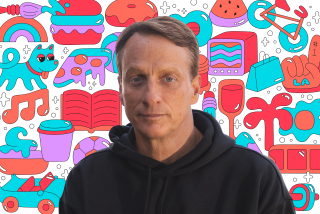Riding a wave of history and commemoration in Santa Monica
“Brother Nick,” said a woman in a white sundress. “Brother Nick, we call on you, brother Nick.”
The sun was rising and a group of surfers stood on a beach in Santa Monica, surrounding longboards and rose bouquets, celebrating a pioneer whose life was cut short in nearby waters 62 years ago.
“Brother Nick ... Brother Nick!”
Together, about 70 in all, they conjured the spirit and memory of Los Angeles’ first documented black surfer. Together they hailed Nick Gabaldon’s quest “to be free, despite all of the oppression” he encountered on the beach.
Saturday’s event, officially dubbed Nick Gabaldon Day, was part memorial, part history lesson — and a chance to spread the joy of riding waves to inner-city kids who don’t tend to think of the ocean when they think of fun.
“Nick paved the way, we’re just moving the legacy forward,” said Gregory Rachal, president of the Black Surfers Collective, a group of enthusiasts who held the event with the help of the environmental group Heal the Bay and others, including Los Angeles County Supervisor Mark Ridley-Thomas.
For Rachal, a county fire captain who learned surfing on L.A. beaches in the 1970s, Gabaldon symbolizes the determination and self-belief required of minorities participating in a sport still often regarded as the domain of whites. Gabaldon began surfing when he entered Santa Monica High in the early 1940s, an era when most L.A. beaches were segregated and the narrow stretch of sand where the event was held, near the Casa del Mar Hotel, was blacks-only and known as the Inkwell.
Saturday, a tent held a historical display documenting the Inkwell and how Gabaldon, who was half-Latino, became an accomplished surfer despite deep prejudice. As a young man, he didn’t have a car and tried to hitchhike on Pacific Coast Highway to Malibu, where most of the top surfers accepted him. But despite the fact that hitchhiking was common, nobody would give him a ride. Undaunted, he often simply jumped into the water at the Inkwell and paddled roughly 12 miles to Malibu.
In 1951, Gabaldon died in a surfing accident at the Malibu Pier. He was 24. Nobody on hand Saturday knew him and many details about his life remain unclear. Still, his story has pushed Los Angeles’ tight-knit community of black surfers to increase their numbers. “In the 1970s, I could go surf these beaches 15 or 20 days and not see a single black face in the water,” said Dedon Kamathi, 63. “It’s different now.”
“Now,” added Rachal, “every time I go out I see someone black, somebody I didn’t know. I’m raising a second-generation surfer ... and today there’ll be a lot of new kids in the water.”
Sure enough, the waves soon filled with youngsters. There were teens from downtown L.A. and grade schoolers from Watts. Some had never set foot in the ocean before; some had been to a beach only once or twice.
Sierra Hood, 7 — brown shoulders quivering, part of a group from the Watts/Willowbrook Boys and Girls Club — held a volunteer’s hand and gingerly made her way into the surf. She looked so scared, it was hard to imagine her getting anything more than her ankles wet. But she kept at it, eventually bending down on a boogie board, her stomach flat against it, and easing through a churn of thigh-deep waves. “When I first got in, I thought I was going to drown,” she said, smiling after that short ride. “Then I looked at the water and it was beautiful. I felt like a fish, and in the water I could see rainbows!” She vowed to one day be a surfer.
More to Read
Sign up for Essential California
The most important California stories and recommendations in your inbox every morning.
You may occasionally receive promotional content from the Los Angeles Times.











